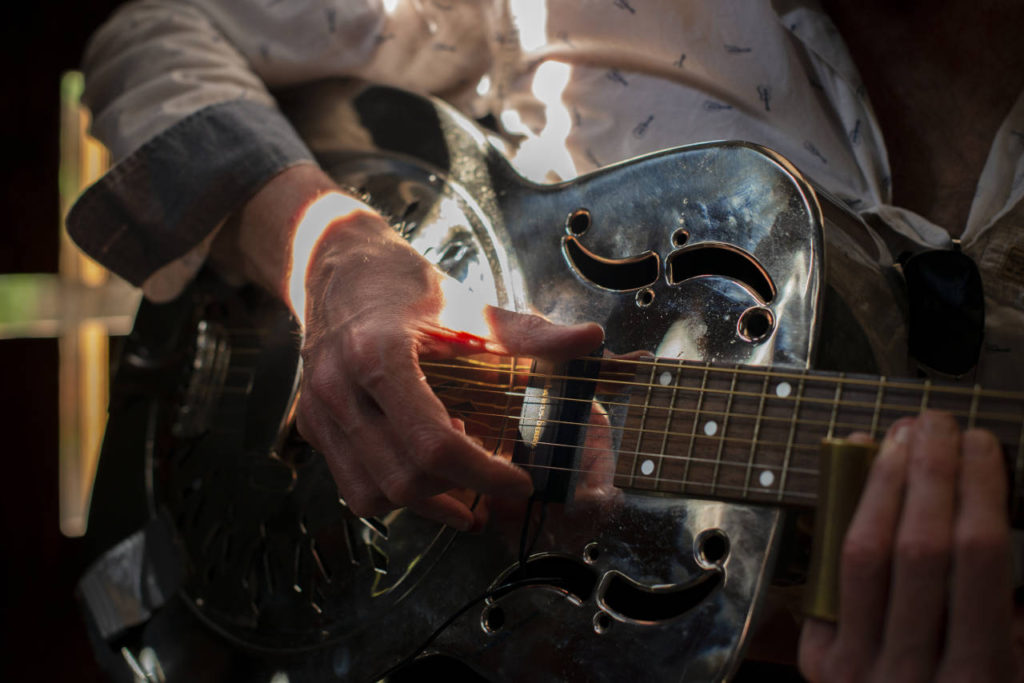This is a beginners guide to blues guitar. There are many forms of blues including the 8 bar (Key to the Hughway, Trouble in Mind), and 16 bar formats (Summertime, I’m your Hoochie Coochie Man), and the 12 bar blues. The 12 bar blues is almost certainly the most common form of blues, a music form that can be traced back to the late 19th century. Blues has its roots in Africa, although it is a quinticensually American music form which has many regional variations including, but not limited to Chicago blues, piedmont blues and mississippi delta blues. Musicians best known for piedmont blues include blind boy fuller, blind willie mctell, and possibly the best known sonny terry and brownie McGhee, with the style characterised by syncopated (meaning the emphasis is moved to between the beats) melody produced by playing the melody with the right and fingers while the right hand thumb keeps the beat.
Chicago blues is often thought of as an electric version of delta blues possibly because some of its best known pioneers, for example, Muddy Waters and John Lee Hooker started playing rural delta blues, but Chicago blues is more than this one style and includes more sophisticated, jazzy sounds.
The 12 bar blues format is perhaps most widly found in Mississippi delta blues, which developed around the turn of the 20th century by plantation workers on the Mississippi delta. It features strong rhythms and a call and response style of singing with repeated phrases often mimicked on the guitar. Charlie Paton was considered king of the delta blues singers, with Son House and Skip James being other well known musicians, and the best known of all is Robert Johnston who was maybe the last delta blues musician.
The 12 bar blues consists of 12 bars with the chords in a specific order. It is almost always played in 4/4 time, so 4 beats to each bar, or in other words, each time there is a chord symbol shown below, it gets 4 beats, or 4 downstrums. The 12 bar blues pattern is shown below in the key of E:
E/E/E/E
A/A/E/E
B/A/E/B
There are many substitutions that can be made to this and some if the most common are shown below:
E/A/E/E
A/A/E/E
B/A/EA/EB
The changes have been made in the second bar where an E has been substituted for an A, and in the bars 11 and 12, the last 2 bars. The last 2 bars of a 12 bar blues is called the turnaround, and is often when chords are dispensed with altogether and replaced by a lick, or a little bit of lead guitar (more on this later). In the example above, there are now 2 chords in bars 11 and 12, so they get 2 beats each.
Now to put some rhythm into the blues…..blues rhythms are based on a triplet feel which is playing 3 strums to each beat. However, this is a bit busy for an authentic blues sound so to create some more space, the 2nd of each group of 3 is left out with another note added to each chord on the 2nd and fourth beats of the bar. Examples of this are found in bares 3 and 4 of the tab below, and forms to majority of the rhythm guitar in the video
The Turnaround
The final 2 bars of the 12 bar blues progression very often get turned into a little fill in order to both end one 12 bar segment and launch into the next 12 bars. Typically the turnaround will start on the I chord (in this case, E), and finish a bar and a half later on the V chord (in this case B7), and there are a couple of turnarounds that are well used, and so are worth learning. I’ve played 3 in the video at the top….the first one is used as a turnaround, a chordal turnaround is used between the first and second times through the 12 bars and a final turnaround is right at the end….all 3 are shown below.
In case the bandwidth has been exceeded for the PDF viewers below, all tabs can be viewed and downloaded on the following links:
Beginner Guide to Blues guitar
Turnaround 1
Turnaround 2
Turnaround 3
Full Tab
The full tab for the video is below:
